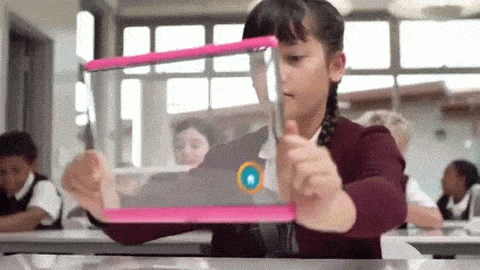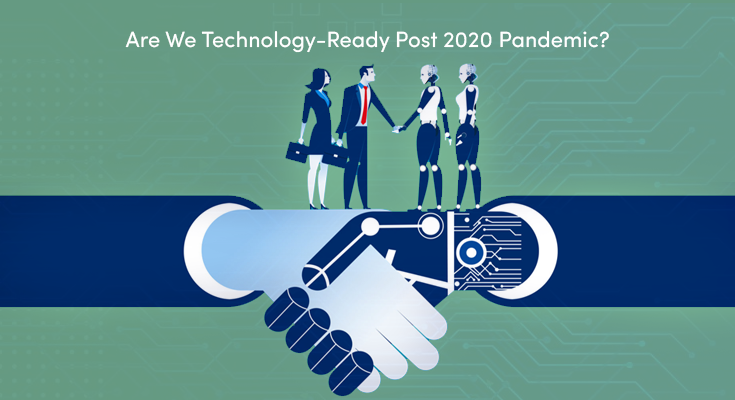With the sights set on returning to the new normal as soon as possible, technology has emerged as an essential tool to avoid stopping any activity in its track.
Certainly, we are not unaware of how technology allied with humans to overcome the Corona crisis where drones were flown to drop medicinal aid, UV-based AI-robots were used to sanitize hospitals, powerful machines and apps were established to detect virus symptoms, live map trackers were deployed to check current active cases, death counts, etc.
Now, what next?
Is still technology primed to cope with the aftereffects?
Can humans rely upon the robust advancements being made in IT, Tech, and Science, anytime soon?
The answers to these questions are revealed as we roll out further.
Undoubtedly, the unprecedented situation, pressingly, demonstrated the significance of digital readiness and led us to adapt ourselves to the New Normal.
There are several changes prevalent in recent months as a result of the pandemic. One of the most important is the telecommuting boom which has grown from 7% before the pandemic to more than 70% today.
And I guess, you must be among one of us working remotely, not allowing any of your services to be disrupted for your online business.
Looking at the other side of the population there are many who were unfortunately forced to reduce or suspend their operations and this is what reasoned for the accelerated development of several existing and emerging technologies.
“A Catastrophe or a Crisis can act as an Accelerant that can Speed up Changes that are on their Way.”
The Web was a boon since its inception and the same can be said in the year 2020 where the Internet offers several ways for all offline and online businesses to improve their sales during emergency time.
How We are Racing to be Future Ready with Technology?

#1 Remote Healthcare
While remote healthcare checkups and telehealth services were a resistance before; however the intervention of remote technology in healthcare has and will further change the history of this domain.
Telehealth was accepted by people quite early but its growth was a bit slow, where about only 10% of the US residents replaced doctor visits or hospitals with telemedicine services a year before the occurrence of the pandemic.
“Teladoc, the largest stand-alone telemedicine provider, reported 50% week-over-week growth in its services the week after isolation orders were implemented across the US.”
The years preceding 2020 will follow a new tradition of ‘Test, Track, and Trace’ that will encourage the adoption of health monitoring technology. With experts stressing the importance of digitization, wearables, and other health monitoring systems will become frequent to use.

Such IoT-based devices will be able to track vital signs of the deadly virus. Such e-devices will be powered by robust software that will connect devices/systems, data networks, and applications.
Access to care is one of the biggest challenges in the pandemic; nevertheless, this will be soon eradicated, bolstering telemedicine firms and enterprises with essential resources to make the requisite technologies a reality.
#2 Enterprise Virtual Reality
With the stay-at-home orders being imposed on everybody, youngsters and kids along with the adults were stuck finding ways to keep themselves away from idleness. It was then when the masses found out an amazing alternative to avoid boredom and stress.
VR headsets were used to play video games, explore travel destinations virtually, and ultimately became a great way of online entertainment when people exercised self-isolation.
In the coming years, many big ventures will be successfully able to experiment with the VR platforms to train employees, connect them virtually, hold conferences, and associate them on projects using all the excellent features that could be added into the VR-enabled apps.
The results of tech advancements could be seen at present times where Virtual Reality has already been used to facilitate training in the field of healthcare. Oxford’s Medical Simulation system is a real-life example that is used to train a large number of medical staff on treating fatal diseases like that of the CoronaVirus.

Although technology experts are still pulled back by the drawbacks of AR/VR hardware in the line of battery life, storage capacity, and computational capacities, nonetheless, they are soon on the way of elimination.
[Prefer reading: “How Does Virtual Reality Actually Work?”]
#3 Remote Learning Technology
As of mid-April 2020, 191 countries decided to implement school/university closures, which is said to impact 1.57 billion students around the globe. Many educational institutions began offering online courses because of quarantine.
With such adverse effects being seen on the future of the global youth, technologies that converge in distance learning were seen as rays of hope and were applied in remote learning seen analogous to remote work. The concept was bolstered by cutting edge technologies of virtual reality, 3D printing, and AI-powered robots as teachers, machine learning apps, etc..

Not only this, but many tech geeks are also continuously hunting for ways how they can successfully implement technology at its best and one such example is set by Yoshiyuki Kakihara who desired to use technology to bring out a solution on English language education for students who were not well-versed with the language.
He created an AI-powered app named Terra Talk that enables its users to have audio conversations. The app is so invented that the Artificial Intelligence algorithms can hear the students speak English, understand what they say, and react to their speech, giving them feedback.
Thus, setting a perfect example of turning “Ideas into Reality” Yoshiyuki is in great hope to make further advancements in the near future, leveraging the evergreen technology of Artificial Intelligence and its subsets.
#4 Enhanced Digital Retail
Online shopping was witnessing a rise, but the COVID-19 pandemic spread it extensively, transforming it into an essential service around the world. It’s true what many believe that a pandemic can merely boost the trends that were already underway.
Today, online shopping is supported by a strong logistics system.

The pressing concern of in-person deliveries, which are not virus-proof, enabled many companies to make a transition towards launching “contactless-delivery” services, where goods are picked up and dropped off at a designated location rather than hand-delivered.
Amazingly, in some places, the deliveries can be seen completed by flying agents Drones, thus, eliminating the need for an individual’s actions.
With even groceries going online, many retailers and marketers have found significant ways to get their business running on the e-platforms. The overlords of the eCommerce domain, Amazon, Walmart, among others, invested high in integrating with the emerging technology of automated fulfillment.
Moreover, they are likely to widen up their share of the online grocery market by augmenting their online grocery shopping experience with technological innovations like a 3D rendering of items as well as customer service improvements and faster delivery times.
While the small ones in the race took aid from third parties to invest in automation, minimizing the chances of non-availability of resources as well as products in the tough times.
In the heading years, many enterprises plan to make a shift towards investing in technology, and thus, availing the facilities of extensively automated machines and sophisticated robotics.
Large e-commerce companies around the world are increasing their development of robot delivery and waste recovery.
[Prefer Reading: “Growth Hacking: A One-Stop Solution for Rapid Business Expansion.”]
#Virtual Customer Service
We are all well known to chatbots and virtual assistants and have also seen their use when the humans were restricted to work and were forced quarantine for their safety. While humans were at rest, bots were at work.

Understanding the need for customer interaction, many industry-specific companies, and retailers embraced virtual assistants and chatbots, realizing their broader aspect of making business.
Considering serious concerns of logistics and eCommerce businesses faced during the high time of lockdown, many companies decide to rely upon conversational agents as the equation between supply and demand becomes complex.
Even though the situation has been handled to some extent at present, what about the future plans that deal with such unforeseen chaotic situations?
Yes, we are ready!
Joining hands with technology, we are ready with the automated screening tools that are capable enough to determine whether patients need in-person medical aid.
We are ready to employ conversational AI Chatbots to automate the routine tasks formerly handled by administrative employees.
Customer support, retail, eCommerce, banking, logistics, etc. we have covered them all by deploying Automated Software Systems and Rapid Response Virtual Agents.

As a business continuity service, we are up with Cloud-based call centers which offer special virtual call center capability to maintain support operations while witnessing any out of the ordinary situation.
- Bright Pattern, a provider of next-generation SaaS Customer Service Management solutions is providing aid to companies who seek support to manage their customer interaction and support activities through virtual call centers.
- Telephone TriageLogic software and services launched a virtual call center platform and have offered it to various healthcare organizations to deploy virtualized support systems, including HIPAA-compliant cloud-based telephony services.
- Wix, website creation and design platform, established a virtualized cloud-based contact center for Israel that helped more than 11k Israeli citizens during its initial three days of service and is expected to do wonders in the coming years too.
What Else Can We Expect in Our Expanding Digital World?
“TOUCH NO MORE”
This will be the principle followed in the proceeding years while implementing the following, taking the best care of social distancing and contactless services.
#Connected lift:
Allowing people in flats, apartments, and office buildings to call ahead and indicate the floor they want to go to using a smartphone app.
#Smart appliances:
Microwaves or coffee machines that can be controlled with voice commands will be a good fit for offices.
#NFC-based tags:
Tags that can enable contactless payments at toll plazas, parking spaces in office complexes, or even in markets.
And much more coming next!



